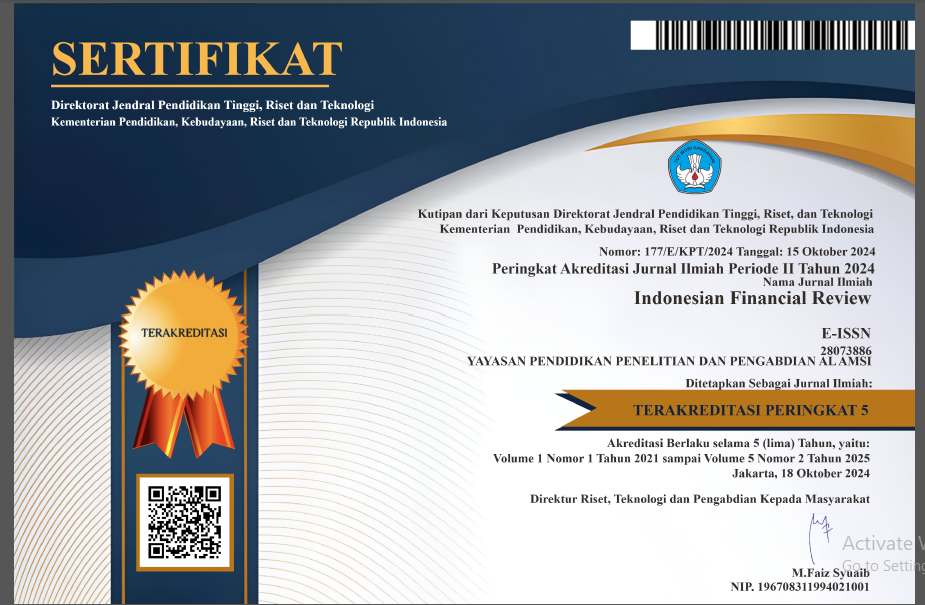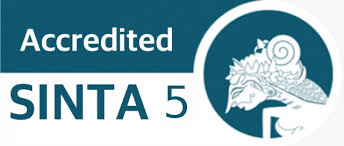Higher Order Moment of IDXNONCYC on Stock Return PT Nippon Indosari Corpindo Tbk Predictability
DOI:
https://doi.org/10.55538/ifr.v2i1.11Keywords:
IDXNONCYC, Co-skewness, Co-kurtosis, GARCH (1,1)Abstract
This study predicts the stock return's of PT Nippon Indosari Tbk with higher order moment of IDXNONCYC. The research method used is time series. Data used are ratios. The tool used is GARCH (1,1). The results are the IDXNONCYC coskewness and cokurtosis lag 1 are significant predicting the stock return’s PT Nippon Indosari Corporindo Tbk. However, IDXNONCYC risk premium lag 1 short fall to predict .
References
processes. International Journal of Forecasting, 37(1), 105–124.
Ang, A., Chen, J., & Xing, Y. (2006). Downside risk. The Review of Financial Studies, 19(4), 1191–1239.
Astuti, E. P., & Lestari, A. (2019). The Effect of Working Capital and Liquidity on Profitability at PT. Nippon Indosari Corpindo, Tbk in 2009-2017. PINISI Discretion Review, 3(1), 21–28.
Badrinath, S. G., & Chatterjee, S. (1988). On measuring skewness and elongation in common stock return distributions: The case of the market index. Journal of Business, 451–472.
Bakshi, G., Kapadia, N., & Madan, D. (2003). Stock return characteristics, skew laws, and the differential pricing of individual equity options. The Review of Financial Studies, 16(1), 101–143.
Bekaert, G., Erb, C. B., Harvey, C. R., & Viskanta, T. E. (1998). The behavior of emerging market returns. In Emerging Market Capital Flows (pp. 107–173). Springer.
Carhart, M. M. (1997). On persistence in mutual fund performance. The Journal of Finance, 52(1), 57–82.
Cerrato, M., Crosby, J., Kim, M., & Zhao, Y. (2017). Relation between higher order comoments and dependence structure of equity portfolio. Journal of Empirical Finance, 40, 101–120.
Chabi-Yo, F. (2012). Pricing kernels with stochastic skewness and volatility risk. Management Science, 58(3), 624–640.
Chabi-Yo, F., Leisen, D. P. J., & Renault, E. (2014). Aggregation of preferences for skewed asset returns. Journal of Economic Theory, 154, 453–489.
Chen, J., Hong, H., & Stein, J. C. (2001). Forecasting crashes: trading volume, past returns, and conditional skewness in stock prices. Journal of Financial Economics, 61(3), 345–381. https://doi.org/https://doi.org/10.1016/S0304-405X(01)00066-6
Christie-David, R., & Chaudhry, M. (2001). Coskewness and cokurtosis in futures markets. Journal of Empirical Finance, 8(1), 55–81.
Conrad, J., Dittmar, R. F., & Ghysels, E. (2013). Ex ante skewness and expected stock returns. The Journal of Finance, 68(1), 85–124.
Dittmar, R. F. (2002). Nonlinear pricing kernels, kurtosis preference, and evidence from the cross section of equity returns. The Journal of Finance, 57(1), 369–403.
Fama, E. F., & French, K. R. (1993). Common risk factors in the returns on stocks and bonds. Journal of Financial Economics, 33(1), 3–56. https://doi.org/10.1016/0304-405x(93)90023-5
Fama, E. F., & French, K. R. (2015). A five-factor asset pricing model. Journal of Financial Economics, 116(1), 1–22.
Fang, H., & Lai, T. (1997). Co?kurtosis and capital asset pricing. Financial Review, 32(2), 293–307.
Guidolin, M., & Timmermann, A. (2007). Asset allocation under multivariate regime switching. Journal of Economic Dynamics and Control, 31(11), 3503–3544.
Hardiyanti, I. Y. (2022). Analisis Rasio Rentabilitas Dalam Menilai Kinerja Keuangan Pada PT. Nippon Indosari Corpindo. Tbk. PARAMETER, 7(1), 168–180.
Harris, R. D. F., Nguyen, L. H., & Stoja, E. (2019). Systematic extreme downside risk. Journal of International Financial Markets, Institutions and Money, 61, 128–142.
Harvey, C. R., & Siddique, A. (2000). Conditional skewness in asset pricing tests. The Journal of Finance, 55(3), 1263–1295.
Jondeau, E., & Rockinger, M. (2012). On the importance of time variability in higher moments for asset allocation. Journal of Financial Econometrics, 10(1), 84–123.
Kraus, A., & Litzenberger, R. H. (1976). Skewness preference and the valuation of risk assets. The Journal of Finance, 31(4), 1085–1100.
Levy, H. (1969). A utility function depending on the first three moments. The Journal of Finance, 24(4), 715–719.
Lim, K.-G. (1989). A new test of the three-moment capital asset pricing model. Journal of Financial and Quantitative Analysis, 24(2), 205–216.
Lubis, I. (2021). Kurtosis and Skewness on Lagged Market Risk Premium in Indonesian Market During Covid 19 Pandemic. Jurnal Mandiri: Ilmu Pengetahuan, Seni, Dan Teknologi, 5(1).
Maheu, J. M., McCurdy, T. H., & Zhao, X. (2013). Do jumps contribute to the dynamics of the equity premium? Journal of Financial Economics, 110(2), 457–477. https://doi.org/10.1016/j.jfineco.2013.07.006
Martellini, L., & Ziemann, V. (2010). Improved estimates of higher-order comoments and implications for portfolio selection. The Review of Financial Studies, 23(4), 1467–1502.
Saputra, A. I. (2021). Influence of Debt To Equity Ratio (DER) and Earning per Share (EPS) on Stock Price PT Nippon Indosari Corpindo Tbk. Indonesian Financial Review, 1(2), 95–113.
Sugiyono, P. D. (2017). Metode Penelitian Bisnis: Pendekatan Kuantitatif, Kualitatif, Kombinasi, dan R&D. Penerbit CV. Alfabeta: Bandung.
Suhud, C. W., Djatnika, D., & Danisworo, D. S. (2022). Penilaian Kinerja Keuangan Menggunakan Metode Economic Value Added pada PT Nippon Indosari Corpindo Tbk. Indonesian Journal of Economics and Management, 2(2), 342–354.
Tukey, J. W. (1977). Exploratory data analysis (Vol. 2). Reading, MA.
Zhen, F. (2020). Asymmetric signals and skewness. Economic Modelling, 90, 32–42.
Downloads
Published
How to Cite
Issue
Section
License
Copyright (c) 2022 Iman Lubis, Syamruddin Syamruddin, Andi Sopandi

This work is licensed under a Creative Commons Attribution 4.0 International License.
















